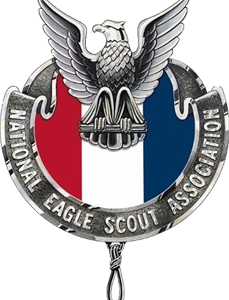The Eagle Scout is the highest rank attainable in the Scouts BSA program. A Scout who attains this rank is called an Eagle Scout or Eagle. Since its introduction in 1911, the Eagle Scout rank has been earned by more than two million young men and women.
Requirements include earning at least 21 Merit Badges and demonstrating the Scouting spirit through the Scout Oath and Law, service, and leadership. This includes an extensive service project that the Scout plans, organizes, leads, and manages. Eagle Scouts are presented with a medal and a badge that visibly recognizes the accomplishments of the Scout. Additional recognition can be earned through Eagle Palms, awarded for completing additional tenure, leadership, and merit badge requirements.
Click here for a list of notable Eagle Scouts

For Current Scouts: Eagle Scout advancement information
Achievement plus lifelong impact
Over one hundred years after Arthur Eldred of New York earned this nation’s first Eagle Scout Award, independent research demonstrates the significant, positive impact Eagle Scouts have on society every day. Since it was first awarded in 1912, more than 2 million young men and women have achieved the Scouts BSA’s highest rank. The study conducted by Baylor University, Merit Beyond the Badges, found that Eagle Scouts are more likely than those who have never been in Scouting to:
- Have higher levels of planning and preparation skills, be goal-oriented, and network with others
- Be in a leadership position at their place of employment or local community
- Report having closer relationships with family and friends
- Volunteer for religious and nonreligious organizations
- Donate money to charitable groups
- Work with others to improve their neighborhoods
National Eagle Scout Association
The National Eagle Scout Association (NESA) is for young men and women searching for dynamic and challenging leadership roles. NESA membership is older Eagle Scouts who support young men and women to become America’s future leaders. The objective of NESA is to serve Eagle Scouts and through them, the entire movement of Scouting.

